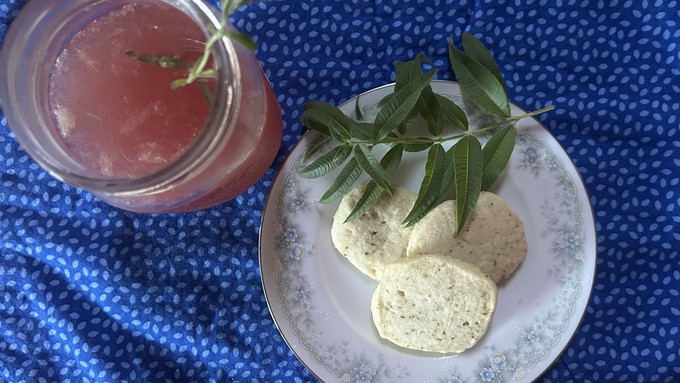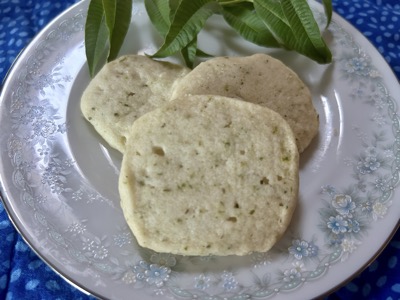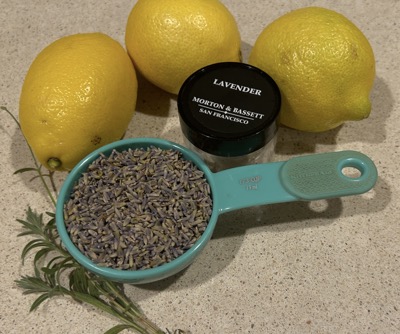
Recipe: Lemon verbena shortbread, lavender lemonade from the Herb Team

Shortbread and lemonade are an excellent treat any time. Use herbs to give them a special touch. Kathy Morrison
At Harvest Day last month, the first of the mini talks, "Beyond Basil: Kitchen Herbs," featured Sacramento County master gardeners Vivian Sellers and Maria Schiffler. These women know their herbs, and they love to share how they grow, save and use different types.
Butl they couldn't share the recipes they referred to, under rules for UC master gardeners. (It's another story with UC master food preservers -- those folks are trained in recipes.)
However, we here at Sacramento Digs Gardening received the OK to be the go-between. So today I can share with you two favorites of the Herb Team: Vivian's lemon verbena shortbread and Maria's lavender lemonade. The delicate cookies and the fragrant lemonade are perfectly paired at afternoon tea or any daytime party.
The star of the Fair Oaks Horticulture Center's herb garden is the lemon verbena lovingly shaped and tended by Vivian over the years -- it now resembles a small tree. The leaves have a heavenly aroma -- one that stays strong even after the leaves are dried. If you want to plant it, check the nurseries that have large herb sections. It grows quickly once established. It might look a bit sad in winter but bounces back well.
The FOHC herb garden also includes several lavender plants, which were harvested in July for the sachets given away at Harvest Day. Some varieties are better than others for culinary uses, if you're shopping for plants. Some lavenders have a more soapy taste and are better in sachets or wreaths. (If you want to learn more about lavender, a good place to start is the website of Morningsun Herb Farm, the Vacaville nursery where the master gardeners found several of the plants for the herb garden.)
For each of these recipes I made partial batches. I had just enough dried lemon verbena leaves for a half batch of shortbread. For the lemonade, since we're long past harvest time, I was delighted to find culinary lavender in the herb section of my local Safeway. That jar was just enough to make one-third of a batch.
But the recipes below are the full amounts as passed along by the Herb Team. My additions are in parentheses.
Lemon verbena shortbread
Makes about 4 dozen cookies
Ingredients:
1 cup (2 sticks) butter, softened (plus 1/2 teaspoon salt, if using unsalted butter)
1/2 cup sugar
2 cups all-purpose flour
2 to 3 teaspoons finely ground dried lemon verbena leaves
Instructions:

Blend butter and sugar well (and the salt if using unsalted butter), then stir in the flour and lemon verbena. Form into logs (mine in the half batch was about 8 inches long) and wrap in plastic. (I added a layer of wax paper over the plastic.)
Chill overnight. (If you want round cookies, start shaping the logs after they've started to firm up. That'll be easier than trying to reshape the very cold dough.)
Heat oven to 325 degrees. Slice the dough about 1/4-inch thick. (Place on a parchment-covered baking pan.) Bake 12-15 minutes, until slightly brown on the edges. Cool on rack. (Cookies are very soft when they come out of the oven, so don't try to remove them for at least 15 minutes.)
These will keep several days in an airtight container. (Vivian sometimes makes these into sandwich cookies with lemon verbena jelly, but that's a recipe for another day!)
Lavender lemonade
Makes about 6 cups
Ingredients:
2 cups boiling water
1 cup dried lavender flowers
1 cup sugar
1 cup freshly squeezed lemon juice (from 6 to 7 lemons, depending on their juiciness)
2 cups cold water
Instructions:

Make an infusion by pouring the boiling water over the lavender in a mixing bowl (or large glass measuring cup). Let steep 10 minutes. Strain; discard (or compost) the lavender.
Pour the hot lavender water over the sugar in a large bowl or pitcher. Stir until the sugar is dissolved. Then add the cold water and the lemon juice. (The lemonade will turn a gorgeous pink color.) Refrigerate before serving; use lemon slices and/or lavender sprigs for garnish.
Tip: Zest those lemons first and save the zest in the freezer for another recipe.
Comments
0 comments have been posted.Sacramento Digs Gardening to your inbox.
Food in My Back Yard Series
May 6: Maintain soil moisture with mulch for garden success
April 29: What's (already) wrong with my tomato plants?
April 22: Should you stock up on fertilizer? (Yes!)
April 15: Grow culinary herbs in containers
April 8: When to plant summer vegetables
April 1: Don't be fooled by these garden myths
March 25: Fertilizer tips: How to 'feed' your vegetables for healthy growth
March 18: Time to give vegetable seedlings some more space
March 11: Ways to win the fight against weeds
March 4: Potatoes from the garden
Feb. 25: Plant a fruit tree now -- for later
Feb. 18: How to squeeze more food into less space
Feb. 11: When to plant? Consider staggering your transplants
Feb. 4: Starting in seed starting
Sites We Like
Garden Checklist for week of May 11
Make the most of the lower temperatures early in the week. We’ll be back in the 80s by Thursday.
* Plant, plant, plant! It’s prime planting season in the Sacramento area. Time to set out those tomato transplants along with peppers and eggplants. Pinch off any flowers on new transplants to make them concentrate on establishing roots instead of setting premature fruit.
* Direct-seed melons, cucumbers, summer squash, corn, radishes, pumpkins and annual herbs such as basil.
* Harvest cabbage, lettuce, peas and green onions.
* In the flower garden, direct-seed sunflowers, cosmos, salvia, zinnias, marigolds, celosia and asters. (You also can transplant seedlings for many of the same flowers.)
* Plant dahlia tubers.
* Transplant petunias, marigolds and perennial flowers such as astilbe, columbine, coneflowers, coreopsis, dahlias, rudbeckia and verbena.
* Keep an eye out for slugs, snails, earwigs and aphids that want to dine on tender new growth.
* Feed summer bloomers with a balanced fertilizer.
* For continued bloom, cut off spent flowers on roses as well as other flowering plants.
* Add mulch to the garden to maintain moisture. Mulch also cuts down on weeds. But don’t let it mound around the stems or trunks of trees or shrubs. Leave about a 6-inch-to-1-foot circle to avoid crown rot or other problems.
* Remember to weed! Pull those nasties before they set seed.
* Water early in the day and keep seedlings evenly moist.